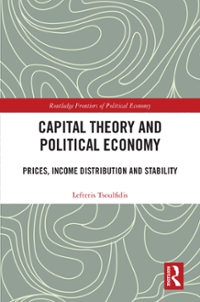Question
Which of the following utility functions are consistent with convex indifference curves and which ones are not? i.(1,2 )=21+52 ii.(1,2 )=(12 ) 1/2 iii.(1,2 )=(1,2),
Which of the following utility functions are consistent with convex indifference curves and which ones are not? i.(1,2 )=21+52 ii.(1,2 )=(12 ) 1/2 iii.(1,2 )=(1,2), where Min is the minimum of the two values of 1and 2. b)Sharon has the following utility function: U(X,Y)=X+Y where X is her consumption of candy bars, with price PX = $1, and Y is her consumption of espressos, with PY = $3. i.Derive Sharon's demand for candy bars and espressos. ii.Assume that her income I = $100. How many candy bars and how many espressos will Sharon consume? iii.What is the marginal utility of income? Question Two Mubangahas 150of disposable income to spend each week and cannot borrow money. She buys milk balls and a composite good. Suppose that milk balls cost 2.50per bag and the composite good costs 1per unit. a)Sketch Mubanga's budget constraint. b)What is the opportunity cost, in terms of bags of milk balls, of an additional unit of the composite good? c)Suppose that in an inflationary period the cost of the composite good increases to 1.50 per unit, but the cost of milk balls remains the same. Sketch the new budget constraint. d)What is the opportunity cost of an additional unit of the composite good?Suppose now Mubangademands a pay raise to fight inflation. Her boss submits and raises her salary so that her disposable income is now 225per week. Sketch the new budget constraint. Is Mubanga better off? Question Three A firm's production function is given by =., where and are capital and labour inputs used by the firm and is output. a)Check the returns to scale for this production function. b)Draw the isoquant map. c)Calculate the marginal rate of technical substitution between and . What will the expansion path look like? d)What are the three stages of production for the short run production function? Depict them graphically. Why does it not make sense to produce in stage 1or 3? Question Four Sesheke real estate company has the following production function and input prices. ()=10000 The costs that Seshekereal estate company has are one thousand two hundred kwacha. It hires labour at thirty kwacha per day and rents capital at forty kwacha per day. a)The aim of Sesheke real estate company is to maximise its output. State its output maximisation problem. b)Evaluate the marginal rate of technical substitution between labour and capital and compare it to the slope of the cost function. c)Using the Lagrange method determine the quantity of labour and capital that maximizes output as well as the level of output. Show this graphically. d)Derive and express the total cost function for Sesheke real estate as a function of output (). e)Assuming perfect competition, derive the short-run supply curve for Sesheke real estate in terms of price, and capital, . Question Five The number of airtel money agents in town has reduced to just about 1000 airtel money agents due to the clean-up exercise carried out by the Lusaka City Council. Let us assume that the market where airtel money agents operate is characterised with features of perfect competition and that the airtel money agents are the firms operating in the market. Currently, supply by each airtel money agent of its services is fixed at 100 services in the short run. All the airtel money agents operating in this market face themarket demand which is as follows =16 10,000 Where is the quantity of the services and is the price. a)Evaluatethe short-run equilibrium price. b)Calculate what the equilibrium price would be if one of the airtel money agentsdecided tosupplynothing or if one airtel money agentsdecided to supply200services c)At the original equilibrium point, calculate the elasticity of the industrydemand curve and the elasticity of the demand curve facing any one airtel money agent. Question Six a)Suppose that a perfect competitive firm's costs are given by ()=(1) 2+2, find the firm's supply curve and profit function. b)Suppose a monopolist faces the following linear demand curve =50 1 2 . If the marginal cost is constant and is equal to 20, i)What is the amount of profits made by the monopolist? ii)What is the deadweight loss or welfare loss of the monopoly? iii)Show on the graph. c)Suppose a discriminating monopolist sells its product in two separate markets with the following demand functions 1 2 1=6 1 2 1 1 2 1=10 1 2 1 Assuming the total cost function is =3+2, where =1+2, find i)Prices to be charged in the two markets as well as the amount of output to be sold in each market that maximizes profits.ii)Total profits. iii)Elasticities, and provide an economic explanation why two elasticities differ. Question Seven Jane has 3 litres of soft drinks and 9 sandwiches. Bob, on the other hand, has 8 litres of soft drinks and 4 sandwiches. With these endowments, Jane's marginal rate of substitution (MRS) of soft drinks for sandwiches is 4 and Bob's MRS is equal to 2. Draw an Edgeworth box diagram to show whether this allocation of resources is efficient. If it is, explain why. If it is not, what exchanges will make both parties better off?
Step by Step Solution
There are 3 Steps involved in it
Step: 1

Get Instant Access to Expert-Tailored Solutions
See step-by-step solutions with expert insights and AI powered tools for academic success
Step: 2

Step: 3

Ace Your Homework with AI
Get the answers you need in no time with our AI-driven, step-by-step assistance
Get Started


